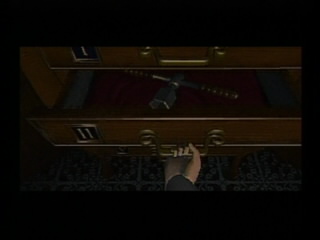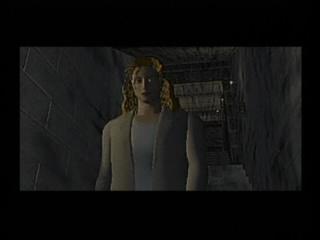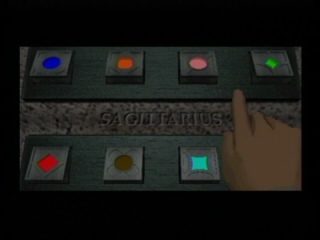
D
|
Version Reviewed: 3DO
Year Published: 1995
Publisher: Panasonic
Developer: WARP
|
 ...
...
There was an episode of Saturday Night Live in which the Al Franken character Stuart Smalley tells a "scary story". In the story, a teenage girl is babysitting for a dysfunctional family. She keeps getting phone calls of someone mumbling incoherently. The "big reveal" at the end of the story is, "The call's coming from inside the house! It's your father and he's been drinking!" D is like the videogame version of that story. It's about equal in length and depth, has a similar "big reveal" moment, and is ultimately about as scary. The main difference between Stuart's story and D is that only one of them was intentionally hilarious.
D feels like some kind of sick joke. Although it is touted as being one of the first survival horror games (think Resident Evil and Alone in the Dark), it is little more than one long FMV sequence with a few Shadowgate-style puzzles sprinkled throughout. To call it "survival horror" is really stretching the definition of both words, since (a) you cannot die, and (b) the game isn't scary at all. It is also extraordinarily short; almost anyone will be able to finish it within one or two hours of play, and the manual even brags about the 2-hour time limit. How shameless do you have to be to boast that your game only takes two hours to complete? I asked myself that question at the beginning of D. By the end, I realized that "shame" does not exist in the makers' vocabulary.
 ...
...
The premise of D is that a well-respected doctor, Richter Harris, has suddenly gone insane, killed all the patients in his hospital, and barred himself inside where the police can't get to him. His daughter, Laura, hears of the news and enters the hospital, at which point it transforms into a castle of medieval design. Occasionally, the doctor's head will appear out of nowhere to harass Laura with vague warnings and threats, but not before repeating her name about 10 times.
The game's packaging promises that by solving the mystery of "D", you will discover the truth about Dr. Harris, but what happens during the next few hours barely counts as "solving a mystery". As Laura, you will slowly...slowly...plod through the castle, walking along set pathways, and solving puzzles. A few of these puzzles are interesting, such as one that forced me to Google search the Zodiac symbols since, not being one to read horoscopes, I was unfamiliar with them. But far too many puzzles consist of simply walking over to a key, looking at it, picking it up, and then walking back to the locked door that requires it.
One puzzle in particular exemplifies some of the worst game design I've ever seen. In this sequence, you must spin a wheel to change a door behind you. There are five doors it cycles through, and in-between them are a total of seven brick walls. The animation of Laura's hand gripping and spinning the wheel takes somewhere between 10-15 seconds. Cycling through to the correct door can easily take over a minute. The worst part is that it didn't have to be this way: The tedium could have been significantly reduced simply by eliminating the stupid brick walls! All at once, it showcases the best and worst aspects of FMV: Yes, we can now show someone realistically spinning a wheel, instead of pushing a button and having it happen instantaneously without any animation like it would in Shadowgate. But, yes, it also means you'll spend at least 10 minutes spinning a damn wheel!
 ...
...
The biggest problem with D is that not much really happens. There's barely any story, so there's nothing to get worked up over. Aside from a battle with an animated suit of armor, there are no monsters. (That battle, by the way, is one of those typical FMV fights that amounts to pushing a button when prompted.) The worst scare the game can muster is opening a door to the sight of mutilated corpses, which is difficult to take seriously, especially since by the second time it happens, Laura's facial expression is that of apathy. The puzzles, though they make up the only part of the game that is good in any sense, are completely unrelated to the doctor's bizarre predicament. Considering how pointless his dialogue is, the overwhelming feeling I got was that information was purposefully being held back so there could be a "big reveal" at the end. I was right. And when you finally arrive at that moment, try not to burst out laughing at it.
If there's anything positive I can say about D it's that the graphics are okay. It is indeed difficult to tell where the FMVs stop and the gameplay begins because the environments and the movement through them all look like FMV. While I hesitate to say that the backgrounds are scary, I can easily imagine that they could have been scary had more effort been put into other aspects of the game. The human character models, however, are typically bad early CGI. Laura's hair looks like porcelain shells, and she's not convincingly animated. Her movements and facial expressions are akin to a marionette. Dr. Harris has a rubbery head and his lip movement never matches his dialogue. He does not seem like a character so much as a model created specifically for the purpose of using goofy special effects on it, including one that makes his head transparent so it can ooze out of walls, and another that covers him in a Jell-O mold. Although D has several different endings, you will never get to see the doctor's complete transformation in any of them, which heightens my suspicions that D exists because someone had a bunch of CGI effects and wanted to show them off. An equivalent scenario would be a werewolf movie in which nobody ever transforms into a werewolf, but instead, someone becomes Max Headroom.
Shadowgate was one of the first games to rely purely on its puzzle-solving and atmosphere to engage the player and keep him/her challenged through to the end. It, too, had very little plot (find and defeat the Warlock Lord), but the dialogue was wonderfully descriptive...to the point that even though the entire game took place in just one castle, the world beyond it took on a life and history of its own. The game's structure, a series of linked events designed to ultimately meet its goal, was tightly interlocked with its mythology and characters' motivations. D's gameplay, on the other hand, exists only to kill time for the moment of revelation. Shadowgate also had genuine mysteries. Some gave immediate affirmation to the wonders of its world. Others hinted at the possibilities of even greater wonders unseen. Because of its conundrums, you are not likely to finish Shadowgate within 1 to 2 hours of playing it your first time. D, in comparison, is both deprived and depraved.
 ...
...
There are those who will claim that D was scary "for its time". I don't buy it. Atmosphere is not synonymous with being scary, and even if it was, slowly slogging through a mansion is not scary on its own. Something has to happen, and it has to happen to a character we care about. Even though you essentially played as "yourself" in Shadowgate, the sheer number of ways you could die and how unforgivingly quickly it would happen easily kept you on edge. In D, Laura can't even die, and I am suspicious that death scenes were misincluded because they would have looked hilarious with the game's graphics engine. I can honestly say that had I'd played D when it was first released, I would have laughed and gone right back to my Super NES.
Although the temptation is there (and the game would certainly deserve it), I will not spoil the secret behind what "D" stands for. I will however, say two things: 1. Stuart Smalley would have a field day with the dysfunction of the Harris family. 2. This is not the first time I can recall the letter "D" has stood for that.
Score: 1.5/5



